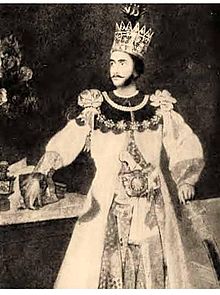Mubarak Ali Khan II
| Mubarak Ali Khan II | |
|---|---|
|
Nawab Nazim of Bengal, Bihar and Orissa (Nawab of Bengal) Shuja-ul-Mulk (Hero of the Country) Ihtisham-ud-Daulla (Victor in War) Humayun Jah (Of Auspicious Rank) Feroze Jang (Dignifier of the Country) |
|

Nawab Nazim Mubarak Ali Khan (popularly known as "Humayun Jah")
|
|
| Reign | 31 October 1824 – 3 October 1838 |
| Coronation | 23 December 1824 |
| Predecessor | Ahmad Ali Khan |
| Successor | Mansur Ali Khan |
| Born | 29 September 1810 |
| Died | 3 October 1838 (aged 28) |
| Burial | Jafarganj Cemetery |
| Wives |
|
| Issue |
Mansur Ali Khan |
| Dynasty | Najafi |
| Father | Ahmad Ali Khan |
| Mother | Najib-un-nisa Begum |
| Religion | Islam |
Mansur Ali Khan
Wahid Hussaib Khan Bahadur
Sultana Ghetiara Begum
and
Sayyid Mubarak Ali Khan II (popularly known as Humayun Jah) was born on 29 September 1810 to Ahmad Ali Khan and by Nazib-un-nisa Begum Sahiba. He was the Nawab of Bengal from 1824 to 1838. He was succeeded by Mansur Ali Khan. He built the famous and renowned Hazarduari Palace and Mubarak Manzil in Murshidabad. Nawab Nazim Humayun Jah died on 3 October 1838.
Mubarak Ali Khan was the only son of Ahmad Ali Khan. He succeeded his father after he died in 1824 under the titles of Humayun Jah (Of Auspicious Rank), Shuja-ul-Mulk (Hero of the Country), Ihtisham-ud-Daulla (Victor in War) and Feroze Jang (Dignifier of the Country).
In 1826 he went to Patna for a change in the dewanship and when he attained his majority he took the management in his own hands, with the plan to dismiss Raja Ganga Dhar from the Nizamat Dewanship.
At Findall Bagh (now known as Mubarak Manzil) the Courts of Justice of the East India Company was erected, however, it was unused after the administration of law and justice was removed to Calcutta. The Sadar Dewani Adalat (courts or darbars) were held here from 1765 to 1781 until it was removed to Calcutta. Subsequently, the Civil and Criminal Courts (which were located here) was transferred by Lord Cornwallis in 1793 by transferring the Supreme court to Calcutta. This spacious property of Findall Bagh was abandoned. There were also three buildings on this spacious property.
In May 1830 Nawab Humayun Jah bought this property from Raja Kissen Chand Bahadur and Kumar Chand of Nashipur for an amount of ₹ 35,000. He transformed the property into a pleasure garden and erected the Moti Mahal (also known as the Red Bunglow) here, he named the garden Mubarak Manzil.
...
Wikipedia
